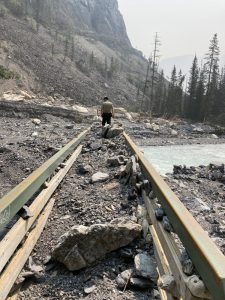Bracing for More Change: Climate Risks and BC’s Parks and Protected Areas
Categories:
The historic heatwave of late June/early July has brought the realities of climate change home to British Columbians. Sudden deaths, the loss of a community, wildfires, loss of flora and fauna, and impacts to agricultural and shellfish sectors, the list is long making it difficult to grasp our unknown future with a new and dangerous climate. Like many other facets of our society, and indeed our world, our protected areas are vulnerable to a changing climate.
Climate change does not respect park boundaries; the cultural and ecological places that our parks protect are also feeling the heat as are the facilities that park visitors love to use. For example, more than 20 parks are closed including some highways due to wildfire. The Berg Lake Trail at Mount Robson is also closed after an extraordinary flood washed away bridges due to the combination of high elevation snowpack and persistent hot weather. Keeping parks safe and open in our changing climate requires significant planning and resources.
Photos of Mount Robson Provincial Park’s Berg Lake following the July 2021 flood event:


While B.C. has always had events like wildfires, floods and droughts, climate change will increase their frequency and severity. These changes are driven by higher levels of greenhouse gases in the atmosphere, created by many decades of activities such as burning fossil fuels and clearing land.
We can’t undo the past and avoid the effects of climate change, but we can be better prepared to adapt and reduce the impacts. The province recently released a draft Climate Preparedness and Adaptation Strategy to help BC prepare for future climate risks. Preparing now can help protect our province from future shocks and strengthen the resilience of our ecosystems, communities and economy. The Strategy is allowing BC Parks to improve our understanding of climate impacts on BC Parks’ infrastructure and operations – an important first step in preparing for an uncertain future. There are also some key steps individuals can take to reduce climate risks and help the province better prepare – both at BC Parks and across the province:
- When visiting a park:
- Plan ahead and prepare. Learn more about Campfire Bans and Safety and respect the provincial fire ban that is in effect until October 15, 2021. Check the park webpage before you leave home so you know if the park is open and safe to access. Roughly 40% of wildfires in British Columbia are person-caused by activities such as open burning, the use of engines or vehicles, dropping burning substances such as cigarettes, or any number of other human-related activities that can create a spark or a heat source sufficient to ignite a wildfire.
- Stay local and enjoy the parks in your region to reduce your carbon footprint. The more greenhouse gases that are emitted, the more the planet warms. We can better maintain our familiar climate if we stop emitting greenhouse gases.
- Review and comment on the draft Climate Preparedness and Adaptation Strategy. The strategy helps to ensure B.C. stays safe and responds effectively in a changing climate. Feedback is welcome until August 12, 2021.




